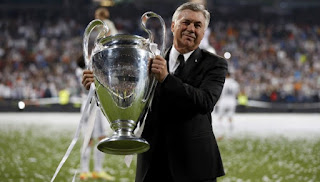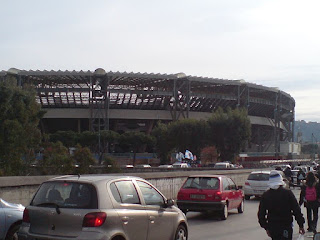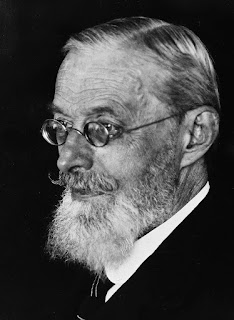Bandit seen by peasants as Italy’s ‘Robin Hood’
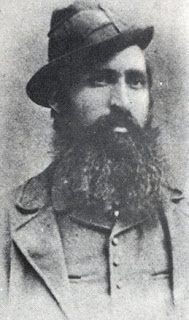 |
Carmine Crocco nurtured a hatred
for people of wealth and nobility |
Carmine Crocco, whose life of brigandry was driven by a hatred of what he saw as the bourgeois oppressors of the poor, was born on this day in 1830 in the town of Rionero in Vulture, in Basilicata.
Crocco fought in the service of
Giuseppe Garibaldi in the
Expedition of the Thousand but was no supporter of Italian Unification and spent much of his life thereafter fighting on the side of the ousted Bourbons and of the peasant people of the south, many of whom were as poor after unification as they had been before, if not poorer.
He assembled his own private ‘army’, including many other fearsome brigands, which at one point numbered more than 2,000 men.
For this reason, he is regarded as something of a folk hero in southern Italy, where there is a popular belief that he robbed the rich to give to the poor in the manner of the legendary English outlaw, Robin Hood.
Nonetheless, when he was arrested for the final time he was tried and convicted of 67 murders and seven attempted murders among many crimes, having led a life of violence.
After his initial death sentence was commuted to life imprisonment with hard labour, which he served partly on the island of
Santo Stefano, off the coast between Naples and Rome, and later on the island of
Elba, off the Tuscan coast, Crocco wrote his memoirs.
He described how his hatred for the wealthy upper classes stemmed from an incident he witnessed as a boy, when his brother, Donato, killed a dog that was attacking the family’s chickens and was then beaten by the dog’s owner, a young lord called Don Vincenzo. When his pregnant mother tried to defend her son, she too was violently attacked, losing her unborn child as a result.
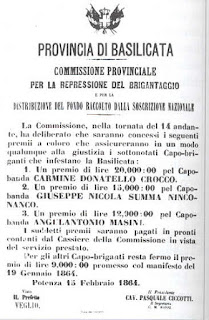 |
An 1864 arrest warrant for Crocco
and two of his accomplices |
Soon afterwards, after Don Vincenzo was threatened with a shotgun, Crocco’s father was arrested and convicted of his attempted murder. Some years later, it was proved that he was not the person with the gun, although by the time his father was released he was old and sick.
Carmine's antipathy towards the privileged classes was hardened further by an incident that occurred when he was an adult. He had been serving in the army of
Francis II, the bourbon King of The Two Sicilies, but deserted after killing another soldier in a brawl.
Returning to Rionero, he found that his sister, Rosina, was the subject of slanderous stories spread by a nobleman, Don Peppino, whose advances she had declined. He sought out Don Peppino, who responded to Crocco’s questioning by hitting him with a whip, at which Crocco drew a knife and killed him.
He hid in nearby woods, where he met other outlaws. They formed a gang and began to carry out robberies. Crocco was caught and sentenced to 19 years in prison in 1855 but escaped from the jail, in Bari, four years later.
His decision to join up with Garibaldi was purely out of self-interest, inspired by the Sardinian general’s promise to grant amnesty to any deserter who joined his cause. Crocco fought bravely, taking part in the important Battle of Volturno, but was denied his pardon. He was arrested and imprisoned again.
He was released after intervention by a noble family from Rionero in Vulture who argued his case, but felt badly betrayed by the Sardinians driving the push for unification. When the new Kingdom of Italy imposed heavy taxes on the peasants while maintaining the privileges of the elite, who had switched their loyalty from the Bourbons to the new country, Crocco called on other former soldiers and fellow outlaws and was able to form an army of 2,000 men, their goal to support
Francis II and to aid and encourage peasant uprisings.
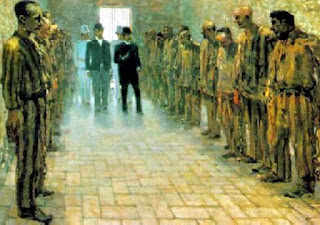 |
Telemaco Signorini's painting of a visit to the prison at
Portoferraio on Elba. Crocco is on the end of the right-hand row |
With the help of the Spanish general José Borjes, sent by the exiled Bourbon government to provide tactical input, they enjoyed considerable success, recapturing many towns across Basilicata and conquering parts of
Campania and
Apulia. Many noblemen and some politicians were killed, quite a few by Crocco himself. This gave him a reputation as “a liberator” but his motives were those rooted in his own past.
The ultimate target was to recapture the city of
Potenza, which had become an Italian army stronghold. But it was here that the campaign began to go wrong. First, Crocco broke his alliance with Borjes, distrustful of his promise of Spanish reinforcements. Then Borjes, en route to see Francis II in Rome, was captured and killed by Piedmontese soldiers.
Crocco went back to robbery and extortion to raise funds but his army had been weakened by numerous battles. He was invited to surrender by the Italian Army but refused, going into hiding with the aim of using guerilla tactics. Ultimately, though, his whereabouts were betrayed by a traitor within his own ranks, the Italian Army brought in reinforcements and he was defeated. Many of his lieutenants were captured and executed.
His own reaction was to flee to Rome, hoping for help from
Pope Pius IX, whom he knew had expressed his support for the southern uprisings and his opposition to unification. But he was detained by papal troops at
Veroli, 100km (62 miles) southeast of Rome and handed over to the Italian authorities. This time there would be no escape.
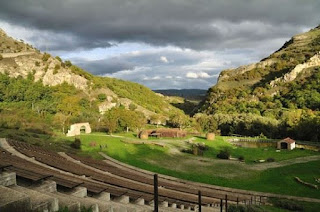 |
| The natural amphitheatre of the Grancia forest park |
Travel tip:
The life of Carmine Crocco is celebrated each year in the village of
Brindisi Montagna, in the province of Potenza, with an open-air musical drama entitled
La Storia Bandita, staged in the natural amphitheatre of the Grancia forest, featuring more than 400 actors and dancers, plus horses, donkeys, oxen and ducks among other animals and multiple special effects, including the illusion of lightning created by more than 600 reflectors. Among a number of famous actors who have taken part is
Michele Placido, who claims to be descended from Crocco through his father, who was born in Rionero in Vulture.
 |
| The Palazzo Fortunato in Rionero in Vulture |
Travel tip:
The most important building in
Rionero in Vulture is undoubtedly the
Palazzo Fortunato, built in the early 18th century, when Carmelo Fortunato, an ancestor of the anti-Fascist politician Giustino Fortunato, moved to the area. It was subsequently extended by other members of the family. Notable people to have stayed in the palace include, in April 1807, the sovereign Giuseppe Bonaparte - brother of Napoleon - Ferdinand II of Bourbon in 1846 and prime minister Giuseppe Zanardelli in 1902. The building currently houses the municipal library.
Also on this day:
1412: The birth of condottiero Ludovico Gonzaga
1898: The birth of shoe designer Salvatore Ferragamo
Home






